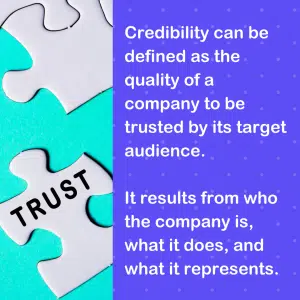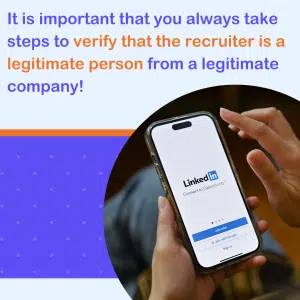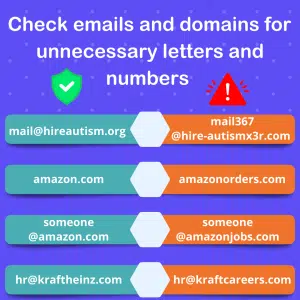*Disclaimer: The following is general information on job scams and is not intended as legal advice.
How To Avoid a Job Scam

Researching A Company Before Applying
Researching a company before applying for a position with them is important as it allows you to learn more about the organization, their mission and values, and also allows you to confirm their credibility.
 A great first step in the research process is to find the company website.
A great first step in the research process is to find the company website.
- If you have found the job listing on an external job board, search the company’s website for employment opportunities and confirm the listing is also on the company’s main web page.
- Browse the website and check out the other pages such as mission, about us, our team, services, etc.
- Check the footer of their website for a privacy policy, which should state the legal business name, any alternative names, and the organization address.
- Look up the organization on the Better Business Bureau.
- Check out their social media presence on LinkedIn, Facebook or Instagram.
- Do a general Google search and check for news articles about the organization, read online reviews, etc.
- Ensure there are no warnings online that question the validity of the organization.
Confirming Recruiter Credentials
Many job boards, social platforms, and company career pages gather information about a job seeker that is then shared with or visible to a wide range of recruiters. This gives recruiters the opportunity to reach out to candidates directly to share a position, see if they are interested, and request that they apply. It is important that you always take steps to verify that the recruiter is a legitimate person from a legitimate company.
- Confirm that their email address is a valid business email and does not have a suspicious domain.
- The user will typically have an email address that incorporates their first and last name or first initial and last name, as well as the domain for their organization.
- Check for unnecessary letters and numbers in the username or domain.
- While it is important to review this closely, it is essential to keep exceptions in mind. For example, larger companies may need to incorporate numbers within the username due to the increased number of email addresses required by their staff.
- Below is an example using the general Hire Autism inquiry email.
- Example of valid email: [email protected]
- Example of suspicious email: [email protected]
- Some additional examples are below.
- Emails from amazon.com, for example, come from amazon.com. Not amazonorders.com. Likewise, if you got a job offer from Amazon, you would receive an email from [email protected], not [email protected].
- If you are looking for a job with Kraft, for example, you would go to a site similar to careers.kraftheinz.com, or get an email from [email protected]. You would not go to kraftcareers.com.
- Search the company website for a staff/team page and search for the individual contacting you. One caveat to this is that not all companies include staff information for all positions.
- Look up the recruiter on LinkedIn.
- Check to see if they are active on the platform, if their experience shows that they work at the organization and a link to that company profile, if they have connections within the company, how many connections they have in general, what their posting habits are, etc.
- Given that their role is recruiting talent, typically, a real recruiter will have an active LinkedIn profile with many connections and will have previously posted about open roles.
- Consider what they are asking of you in their message. Typically, upon first connecting with you, a recruiter will share information about the job or send a link to the position description and ask for the following:
- Contact details: email, phone number
- Resume
- Availability for a call/meeting
- If they have sent you any links, you may want to open another tab, go to the listed company website, and confirm that the link matches the position link on the company’s career page. This is an important step in vetting a company’s overall credibility.
Continue to the next page to learn about protecting yourself after a job scam.




